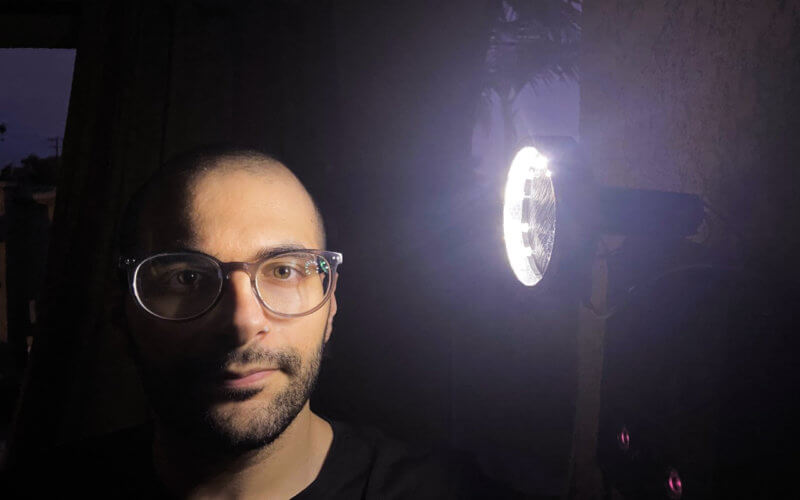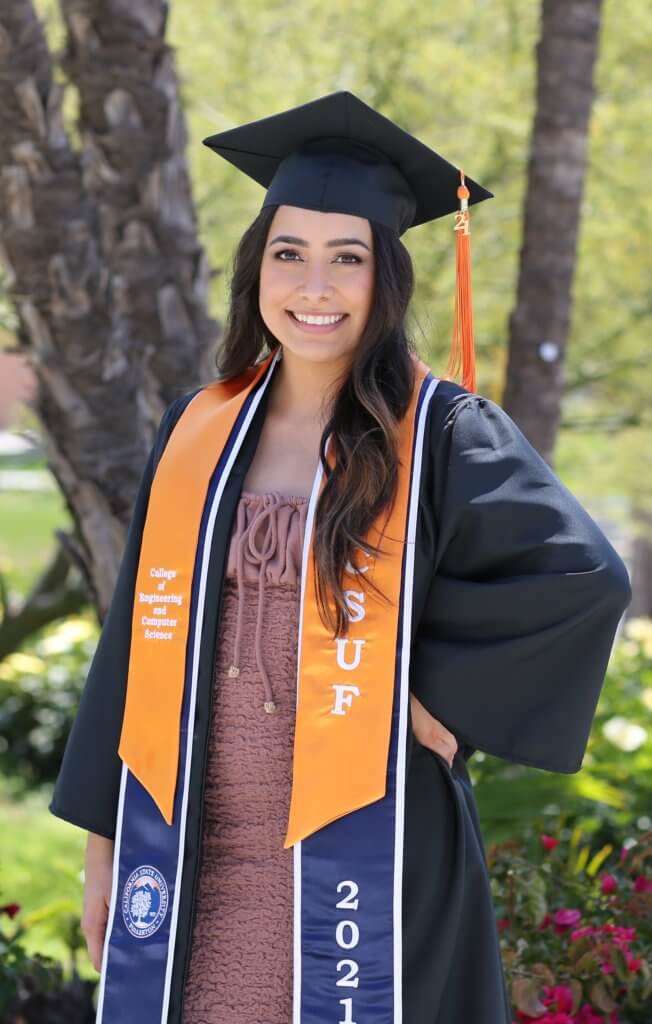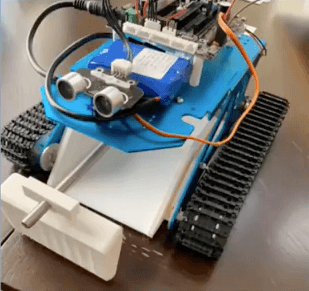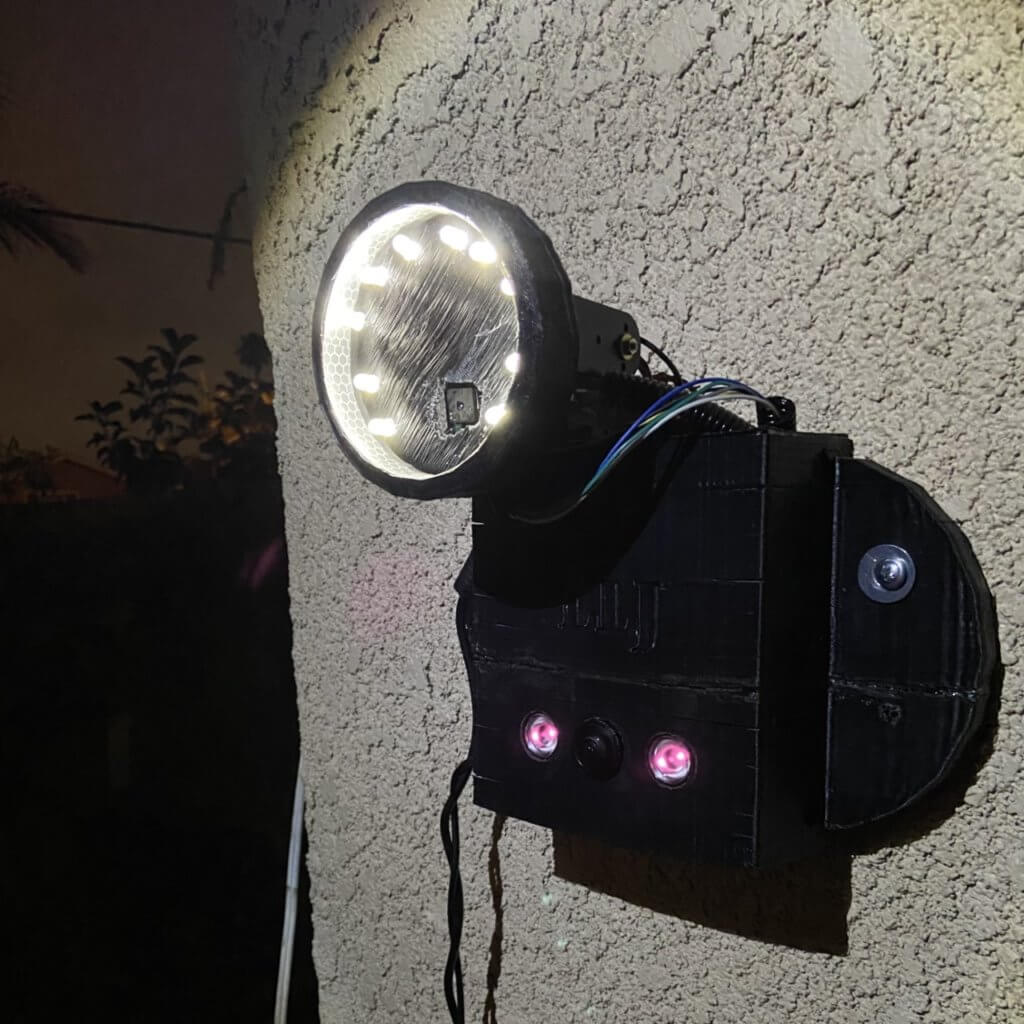
For dog owners who don’t like picking up their four-legged friends’ waste, the robotic “Scoop-A-Tron” will do it for them.
Or, for those who don’t have time to play games with their dog, “FetchBot” will do the trick. The autonomous robot keeps a pet entertained by chasing and retrieving a tennis ball.
And while many modern home surveillance cameras passively record intruder incidents, this new-fangled device uses thermal technology and computer vision to track the movement of prowlers. The thermal camera and bright LED lights can stop intruders in their tracks.
These are just a few examples of the nine innovative research projects created by Cal State Fullerton computer engineering undergraduates. The students, all class of 2021 graduates, presented their year-end projects during the recent virtual “Computer Engineering Capstone Senior Design Project Presentations and Demo.”

The graduating seniors developed and built prototypes using computer hardware and software components as part of a two-semester senior design project course. The projects are intended to mimic the full spectrum of engineering design experience comparable to what is encountered in industry, said Kiran George, professor of computer engineering and faculty adviser for the course.
“The capstone design projects help students get prepared for the workforce by giving them a well-rounded experience. Students are able to relate the theoretical concepts they learn as part of their coursework to real-world applications,” said George, the university’s 2020 Outstanding Professor. “These projects require students to think independently, do research and brainstorm different concepts.”
The students, in which most of whom have landed engineering positions following graduation, faced design challenges, encountered hardware and software issues and 3D printing problems, and even lacked the ability to test prototypes in person together due to the pandemic. But in the end, the students remained focused on creating real-world computer engineering solutions for everyday products.
Scoop-A-Tron

Student team: Illianna Izabal, Turrell Crossley, Kevin Hunt and Josh Mitchell
Product: The Scoop-A-Tron is an automated robot designed to pick up dog waste. With a high percentage of American households owning a dog, this robot can greatly increase the efficiency of individuals’ lives. This robot is intended to have two different types of functionalities, where the user has the choice to have the robot roam around an enclosed yard or follow the pet on walks. In both cases, a camera is connected to a live object detection model.
Inspiration: Caring for a dog requires responsibility and time. The most dreaded task is to pick up their waste. This is a challenge for many owners due to the smell, mess and time it takes to perform this menial task. To overcome this obstacle, an automated robot capable of picking up after the dog would be of great use.
Marketability: This project can be marketable, further work and optimization would be needed to have it ready for the public. There are multiple future works for the Scoop-A-Tron that allow for this invention to have possibilities. The first would be to further enhance the pickup mechanisms so that the robot is able to work on grass surfaces and pick up different states of waste, such as liquids.
Quote: “The ability for a dog owner to clean up after their pets without having to do it manually would be a huge improvement. The owners would be able to find more time in their day and no longer would have to do a menial task,” said Izabal, now a system engineer at Raytheon Technologies.
FetchBot

Student team: Ryan Mauricio, Kevin Hart and Alisha Manookian
Product: FetchBot is a robot that can simulate a game of fetch with a dog autonomously. With it, a dog can be entertained without its owner needing to be physically in the same room.
Inspiration: A product called the “iFetch” served as the main inspiration. This toy is similar to FetchBot in the sense that a dog can utilize it to play a game of fetch by dropping a ball in a funnel. The team wanted to make a product that is autonomous, which comes with the added benefit of collecting left out or forgotten tennis balls to jump start the next game of fetch.
Marketability: The students’ combined love of dogs made the team realize how much pets can mean to their owners and that there is a market for this project. The team is currently discussing whether to make that next step, which would require some major changes to the ball collection and launch process.
Quote: “Due to complications from the pandemic, and since this was our first time creating an autonomous project, there were certainly many challenges our team encountered,” said Mauricio, a software engineering intern at Printronix. “Our collection system required a major redesign in the beginning after realizing flaws with our first design. This also affected our launching system. These are problems we would need to address in the future to make our product as seamless and intuitive as possible.”
Auto Tracking Security and Surveillance Spotlight

Student team: James Samawi, Levi Randall and Lucas Walcher
Product: The Auto Tracking Security and Surveillance Spotlight is a wall-mounted, night vision- and thermal camera-paired device that autonomously tracks an intruder while shining a bright, deterring light at them. The spotlight can livestream the night vision camera footage to a website and send email notifications upon detection of an intruder. The novel feature of this project is the thermal micro camera, which is used as a second layer of human identification and for auto tracking.
Inspiration: The team was inspired by autonomous object-tracking robots and this inspiration led to finding ways to implement such technology into a device meant for home, company or military security. The students pondered various methods for detecting the presence of humans, including from sound triangulation using microphones to thermal camera heat signature detection.
Marketability: This project can be marketed towards commercial, military or any high security location usage. Thermal imaging is a military technology and new to the consumer market. Thus, the thermal micro camera is an expensive part and it can be a challenge to sell in a consumer market with other competitor camera prices.
Quote: “Modern surveillance cameras do not deter intruders. Our project is a gateway to a new era of surveillance camera technology by adding an additional layer of human identification via thermal camera imaging,” said Samawi. “This device is intended to be deployed in a front yard or backyard or any high security location, with the best performance in a dark or enclosed environment.”
This project received the “Best Software Project” and a $750 cash prize in the 2021 College of Engineering and Computer Science Student Projects Virtual Competition and Showcase.